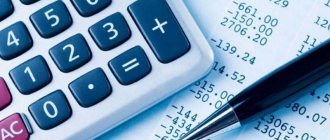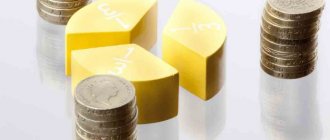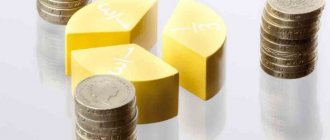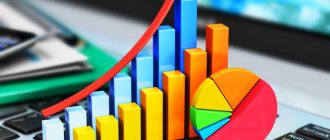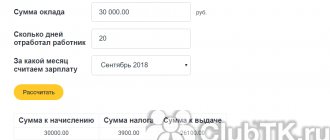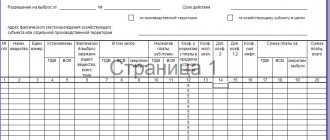Each company in the course of its life acquires so-called liabilities and assets. The former work for the future, and the latter - for the production circumstances of the reporting period. The company's moving resources that participate in daily, monthly turnover and generate income in the short term are called current assets, also known as current assets, short-term assets, and/or mobile assets. Since current assets are mobile, their accounting requires constant close attention. Current assets on the balance sheet are an autonomous category; the balance must be taken into account correctly for the accounts included in it.
Definition
Current assets are a set of material assets that serve the operating activities of the company and are used in one production cycle. The main task of such assets is to cover daily expenses and maintain the functioning of the enterprise.
Current assets include all property that may belong to a legal entity by right of ownership:
- money located in the cash center and in current accounts;
- accounts receivable;
- shares, savings and deposit certificates, bonds;
- materials, fixed assets, finished products;
- copyrights, patents;
- unfinished production;
- attachments.
Data reflection
Information about the structure and amount of working capital is entered into the second asset section of the balance sheet. The cost for each object at the beginning and at the end of the reporting period is indicated here. The stock includes the total price of all material assets and expenses of the organization. Inventory and equipment are recorded in accounting at actual cost. The balance sheet shows:
- Investments in products that have not passed all stages of technological processing, testing, and technical acceptance are included in the cost line in work in progress.
- The standard or actual cost of the balance of manufactured products, as well as those purchased for subsequent sale, is in the column of finished goods for resale.
- Expenses that the company incurs in the current period, but they relate to future years, are included in the expense line for upcoming periods.
- The actual cost of products supplied to customers is in the column of shipped goods.
- Current assets not reflected in the previous lines are included in other costs and inventories.
- VAT on purchased assets shows the amount not claimed for credit.
- Accounts receivable. It is reflected in two subsections depending on the repayment period: within or after 12 months. after the reporting date.
- An enterprise's investments in bonds, shares and other securities are classified as short-term financial investments. Loans provided to other companies for a period of no more than a year are also reflected here.
- Balances of money in letters of credit, accounts (currency and settlement), in the cash register, on check books and other payment documents.
Kinds
Current assets accompany the uninterrupted processes taking place in the organization: financing, purchasing, production, sales, sales. Such assets can be characterized as having the following characteristics:
- high mobility and ability to change, in other words, they can be transformed from one type to another during the commodity-money-commodity process;
- adaptability to changes occurring in the commodity and financial markets, since they are capable of changes if the company changes its type of activity;
- having high liquidity;
- comparative ease of management, since management decisions based on their turnover produce results in a short time.
The disadvantages associated with working with current assets include the following features:
- part of the assets in the form of cash or receivables may lose their value due to inflation;
- temporarily free assets are not able to generate profits, with the exception of those used in “quick” investments, and even vice versa: excessively generated inventories of goods and materials cause additional costs for storage and processing;
- Inventory of any content is prone to losses associated with the natural loss of the product.
The concept of current or current assets
The table below clearly demonstrates the company's asset structure.
Current or current assets are part of the total assets of an organization whose circulation period is less than 1 year . It can be longer, but only if this is due to the peculiarities of the production cycle of a particular enterprise. In the balance sheet these are the lines of the second section.
Current assets are divided into:
- Production assets that are completely consumed in the manufacturing process, and within just one cycle, as a result of which their cost is fully included in the price of the finished product. These are stocks of materials, objects of labor, work in progress. This also includes expenses incurred at the current time, but the purpose of which is to ensure production in the future.
- Circulation funds that do not take part in the production process. These are finished products, money, debt to customers who have been granted a deferment, etc.
Accounting
Due to the fact that the property of the enterprise is distinguished by its heterogeneous formation, it is accounted for using different accounting accounts adopted by the Ministry of Finance, pr. 94n dated 10/31/2000. For this purpose, 50, 51, 52, 58, 10, 41, 62 and similar accounts are used, located in the sections “inventory”, “cash”, “settlements”, “finished products/goods”.
Debts intended for repayment are related to negotiable property because, to some extent, they are already invested funds that are the property of the company. The accounts mentioned are grouped in the balance sheet into a certain number of lines. To understand what data should be entered into each of them, a special formula is used.
Balance
The turnover of current assets does not last more than 12 months from the end of the reporting date, which is why they are also called short-term. Assets with long-term turnover will already be long-term. The balance sheet form approved by Order of the Ministry of Finance No. 66n dated July 2, 2010 reflects the following list of mobile assets:
Current assets are classified as current assets in the balance sheet. However, it must be taken into account that in the combination of current assets in the balance sheet, accounts receivable with long repayment periods are also displayed. This type of debt is part of the final parameter of the value of mobile assets on the balance sheet, named in line 1200 under the heading “Total for Section II”, however, it could be reflected in the part of current assets - based on Accounting Regulations 4/99 clause 19.
Classification of short-term assets
Short-term assets can be classified according to their place and role in the production process into short-term assets in the sphere of production and assets in the sphere of circulation
.
Establishing the optimal ratio of short-term assets in production and circulation is important for providing funds for the implementation of the production program. It is also one of the main factors in increasing the efficiency of use of short-term assets.
The predominant part of short-term assets in the production sector
constitute inventories - raw materials and materials, work in progress, semi-finished products and components, fuels and lubricants, containers and packaging materials, individual items as part of funds in circulation: inventory, household supplies, tools, equipment and fixtures, replacement equipment, special (protective) ), uniform and branded clothing and shoes, temporary (non-title) structures and fixtures and others.
The main purpose of short-lived assets in production is to ensure a continuous and rhythmic production process.
To short-term assets in the sphere of circulation
include finished products and goods, cash on hand and in bank accounts, short-term accounts receivable, short-term financial investments. Their main purpose is to provide resources for the circulation process. The amount of finished products, shipped goods, short-term receivables is influenced by such factors as the conditions for the sale of products, the forms and state of payments, the payment discipline of counterparties, the situation in the financial and commodity markets, and others. Recently, there has been a tendency to crowd out the most liquid assets due to the growth of short-term receivables. At the same time, the share of cash decreases, and short-term receivables grow and amount to significant amounts.
According to the degree of planning, short-term assets are divided into normalized
and
non-standardized
. Normalized short-term assets are those assets for which it is possible to establish planned stock standards and standards for elements. It is not possible to calculate the size of non-standardized short-term assets, so their volume is determined promptly. These include short-term accounts receivable, short-term financial investments, cash and settlement funds.
According to the sources of formation, short-term assets are divided into own, borrowed
and
attracted
.
According to the forms of functioning, short-term assets can be in monetary
, and in
material
form. The monetary form is cash, short-term financial investments, short-term receivables, value added tax. The material form is reserves.
According to the period of operation, short-term assets are divided into a permanent part (systemic)
and
a variable part (varying)
. The constant part of short-term assets represents a constant part of their size, which does not depend on seasonal and other fluctuations in the operating activities of the organization and is not associated with the formation of inventories of seasonal assets, early delivery and designated purposes.
The variable part of working capital is its varying part, which is associated with seasonal growth in the volume of production and sales of products, the need to form, in certain periods of the enterprise’s economic activity, inventories of seasonal assets or early delivery and intended purpose.
Based on the degree of liquidity, there are distinctions between slow-moving, fast-selling and absolutely liquid.
short-term assets.
Depending on the degree of risk, short-term assets with minimal, small, medium and high investment risk
.
In order for the process of production and sale of products to proceed continuously, it is necessary that short-term assets remain simultaneously at all stages and in all forms.
Valuation of short-term assets
In the process of financing and lending short-term assets, their valuation plays a decisive role. It serves as the basis for determining costs, generating financial results and including products, goods, works and services in the price. The leading place in the total valuation of short-term assets is occupied by the assessment of inventory inventories .
The assessment of inventories is carried out in accordance with the Resolution of the Ministry of Finance of the Republic of Belarus dated November 12, 2010 No. 133 “On approval of the Instructions for accounting of inventories and the recognition as invalid of certain resolutions of the Ministry of Finance of the Republic of Belarus and their individual structural elements”
Inventories are accepted for accounting at actual cost.
Actual cost of inventory
acquired
for a fee
is determined in the amount of the organization's actual costs for the acquisition. Actual inventory acquisition costs include:
ü cost of inventories at purchase prices;
ü customs fees and duties;
ü fees paid to the intermediary organization through which the supplies were purchased;
ü costs of procurement and delivery of inventories to the place of their use, including insurance costs;
ü costs of bringing inventories to a state in which they are suitable for use for the purposes envisaged by the organization;
ü transportation, procurement and other costs directly related to the acquisition of inventories.
The costs of bringing inventories to a state in which they are suitable for use include the organization's costs of processing, processing, refining and improving the technical characteristics of purchased inventories that are not related to the production process. When such work is performed by third parties, the costs of bringing inventories to a state in which they are suitable for use include the cost of the work performed and the costs of transportation to the place of work and back, loading and unloading.
The transportation and procurement costs associated with the acquisition and delivery of inventories to the organization include:
costs of loading into vehicles and their transportation, payable by the buyer in excess of the price;
remuneration for services rendered due to intermediary organizations;
storage costs at places of purchase, at railway stations, ports;
other costs directly related to acquisition and delivery to the organization.
They are not included in the actual cost of inventories, but are expensed for the reporting period in which they were incurred:
interest on loans, loans received for their acquisition, as well as remuneration to banks for servicing these loans;
remuneration to banks for opening and executing letters of credit for settlements for purchased inventories;
costs for maintaining supply departments and other services of the organization with similar functions, as well as for storing inventories in the organization;
exchange rate differences on obligations in foreign currency to suppliers for purchased inventories;
costs associated with the acquisition of foreign currency for settlements with suppliers or repayment of loans;
sales costs;
other costs not directly related to the acquisition and delivery of inventories and bringing them to a condition suitable for use.
Goods purchased by the organization for sale
, are valued at their acquisition cost. Organizations engaged in retail trade can evaluate purchased goods at retail prices.
Actual cost of inventories during their manufacture
in the organization is determined in the amount of actual costs associated with the production of these inventories.
Actual cost of inventories contributed as a contribution to the authorized capital of the organization
, is determined based on an assessment of their value made in accordance with the law.
Actual cost of inventories received by the organization free of charge
, is determined based on the price at which, in comparable circumstances, the organization usually establishes the value of the same or similar inventories, or based on their market value on the date of acceptance for accounting.
Actual cost of inventories acquired in exchange for other non-cash assets
, the market value of the inventory received is recognized. The difference between the market value of the inventory received and the value of the transferor's inventory is recognized in financial results. If the market value of inventories received in exchange for non-monetary assets cannot be determined, then the inventories are accepted for accounting at the cost of non-monetary assets transferred or to be transferred to another organization, at which they were reflected in the accounting records of the transferring party.
The actual cost of inventories also includes the organization's actual costs of delivering inventories and bringing them into a condition suitable for use.
When releasing inventories into production or otherwise disposing of them, they are assessed in one of the following ways:
ü at the cost of each unit;
ü at average cost;
ü at the cost of the first inventory purchased (FIFO method).
The application of one of the listed methods for a group (type) of inventory is carried out during the reporting year and is determined in the accounting policy of the organization.
Valuation of inventories at average cost
is made for each group (type) of inventories by dividing the total cost of the group (type) of inventories by their quantity, consisting respectively of the cost price and the amount of balance at the beginning of the reporting period and the received inventories during this reporting period.
Valuation at cost of the first inventory purchases
(FIFO method) is based on the assumption that inventories are used during the reporting period in the sequence of their acquisition (receipt), that is, inventories that first enter production (sales) must be valued at the cost of the first in the sequence of acquisitions, taking into account the cost of inventories listed At the beginning of the reporting period. When applying this method, the inventory held in stock (in warehouse) at the end of the reporting period is assessed at the actual cost of the latest acquisitions, and the cost of goods sold, products, works, services takes into account the cost of earlier acquisitions.
The valuation of inventories at the end of the reporting period is carried out depending on the accepted method for valuing inventories upon their disposal.
Inventories that are obsolete, damaged, or whose selling price has decreased are reflected in the balance sheet at the end of the reporting period less a reserve for impairment of the value of tangible assets.
Materials intended for use in the production of products are not discounted to a level below their cost if the finished product, which they will be included in, is expected to be sold at a price corresponding to the cost or above the cost.
When inventories are disposed of, their cost, as recorded in the organization's books, must be recognized as expenses in the reporting period in which the corresponding income is recognized.
An important problem for organizations is to ensure the necessary structure of short-term assets. The presence of sufficient reserves of materials, individual items as part of assets in circulation, work in progress, determined by their standardization, ensures the continuity and rhythm of production processes. At the same time, problems arising with the sale of finished products lead to unjustified growth. Periodically arising difficulties with settlements between entities cause an increase in short-term receivables, which can turn into long-term receivables, which, in turn, does not allow enterprises to purchase the necessary material assets to resume production in the absence of sufficient profits.
The economic conditions in which organizations operate also have a significant impact on the status of inventories. Increasing prices for purchased goods and materials leads to the formation of organizations with a lack of their own financial resources. As a result, enterprises are forced to resort to unjustified loans, which negatively affects their financial results. High interest rates on loans do not allow many entities to take advantage of credit resources, thereby pushing them towards bankruptcy.
The lack of financial resources forces the organization to resort to loans and borrowings, look for unplanned sources of funds, and violate financial discipline.
The growth of excess stocks of finished goods and work in progress leads to a slowdown in their turnover, reduces the efficiency of the organization, and worsens its financial condition.
Therefore, the organization must exercise systematic control over the safety of short-term assets and their effective use through analysis, audits and surveys based on statistical data, operational and accounting reporting.
Odds
There are a number of ratios for valuing current assets.
Absolute liquidity
The AL coefficient is equal to the ratio of funds in monetary terms and short-term financial investments to current liabilities and is found by the formula:
The source of the calculated parameters is the enterprise's balance sheet in the same way as for calculating the current liquidity ratio. Only this time, money and/or funds that can replace them are accepted as a component of assets.
The optimal value of this coefficient is considered to be no less than 0.2.
Current liquidity
The financial ratio, which is equal to the ratio of current assets to current liabilities, is called the current liquidity ratio and is calculated by the formula:
This multiplier shows the company’s ability to fulfill “short”, that is, mobile obligations with current assets owned by the company. A high value of this indicator symbolizes the success of society in its ability to meet its obligations.
The optimal multiplier value is 2 or slightly more. A weight less than 1 indicates excess financial risk, which may be associated with the company's inability to pay bills. More than 3 indicates an unreasonably arranged capital portfolio.
Quick liquidity
The BL coefficient is equal to the ratio of high liquidity current assets to current liabilities and is calculated in accordance with the formula:
The source of the parameters is the balance sheet, in exactly the same way as for determining current liquidity. This time, production and material inventories are not considered in the total assets. This is due to the fact that with hasty implementation, forced losses will become the largest of the funds available in circulation. This coefficient indicates the ability of the enterprise to meet current obligations in a situation where difficulties arise with the sale of manufactured products.
A coefficient level of at least 1 is considered optimal.
Essence, functions, sources
Current, or short-term, assets are the assets of the company that are converted into cash within the calendar year to fulfill the current budget and tactical tasks of the company. In practice, they account for the bulk of the total capital of the enterprise. Short-term assets, in essence, are a combination of the organization’s material assets that contribute to the company’s activities and the timely repayment of short-term obligations during the calendar year.
This capacious definition still does not fully reflect the essence of current assets. It must be remembered that with the subsidization of a certain amount of capital, a similar process is carried out in the cost funds of additional goods manufactured by the enterprise. Therefore, for companies with high profitability, the amount of subsidized mobile assets increases by a certain component of net income.
For enterprises with low profitability, the value of mobile assets at the end of the annual turnover may decrease significantly.
We can say that short-term assets are money intended for the creation of current resources and circulation resources of the organization. With all this, the main purpose is to reduce the size of subsequent injections to minimum costs, guaranteeing high efficiency of the enterprise and the ability to timely repay obligations to lenders.
Concept and characteristics
Current assets are assets that:
- with a reasonable degree of certainty will be realized, sold or consumed within 12 months. or during the normal operating cycle of the company;
- necessary for the daily operation of the enterprise and solving current problems;
- are easily converted into cash and can be used to pay off short-term obligations.
If long-term assets can be compared to a “skeleton” in the entire “organism” of an enterprise, then short-term assets are all its other “organs and tissues.” The share of each category of assets in the total capital of the company is distributed in approximately the same ratio - capital assets make up the majority of the company’s total funds. Another important characteristic of current assets is their greater liquidity compared to non-current assets, since they can be easily sold.
Structure and classification
The system of current assets is heterogeneous; it consists of different components that create its structure in the final phase. The main components of this structure include:
- all inventories of the enterprise - finished and/or shipped products, unfinished production, materials, costs during the reporting period, costs of selling products;
- cash and cash equivalent;
- accounts receivable;
- investments in a short period;
- long-term assets held for sale;
- VAT calculated for goods purchased by the organization.
In addition, current assets are divided into:
- attracted - this is the usual, so-called accounts payable, that is, the goods have been received and can even be sold, but the money for it has not yet been paid to the supplier;
- borrowed – bank and commercial loans that cover the need for small “short” loans;
- own - a typical source of formation of the organization's timeless needs for funds.
Short-term assets are also divided according to the degree of liquidity: from A1 to A4 - from the most liquid to the most difficult to sell. Short-term assets are subject to classification according to the period of their operation or operation into variable and fixed parts. The variable changes at all stages of the enterprise’s activity and depends on demand and seasonality. The constant part does not change and is not associated with changeable factors and aspects of the company’s functioning.
Assets and liabilities of the organization
An organization's assets are everything that can be converted into cash resources when needed. These also include direct monetary resources. They are used to pay for the company's basic financial needs, payments to suppliers, customers and other entities that provide services to the organization.
An organization's liabilities can be called the opposite of assets. This is what the organization must pay in the near future. These could be debts to suppliers, customers, or outstanding loans. Everything that requires the organization to contribute financial resources in order to repay them.
Need some teacher advice on a similar topic? Ask a question to the teacher and get an answer in 15 minutes! Ask a Question
Assets are an organization's primary resource, what it uses in its daily activities and what makes it exist. When an organization's assets exceed its liabilities, it is successful and can function quietly without any problems.
Figure 1. Classification of obligations. Author24 - online exchange of student work
When an organization's liabilities exceed its assets, the company is close to bankruptcy. If the situation does not change in the near future, there is a risk of liquidation of the organization. If the number of liabilities and assets of the organization is the same, the organization is on the verge of its profitability.
Turnover
The indicator reflects the number of completed product turnover cycles in a certain period. Or according to another scenario: it characterizes the number of turnover of a monetary unit of assets for the period being analyzed, as well as how many units of finished products in monetary terms each unit of current assets brought. This indicator is considered by investors when making a decision to invest in a project when assessing the effectiveness of a possible investment of capital.
